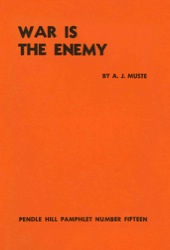Synopsis
Non-violence, pacifism, and non-pacifism are discussed in a search for the truth rather than as philosophical adversaries.
About the Author(s)
“Abraham Johannes Muste, born on January 8, 1885, died on February 11, 1967. Born in Holland, he was brought to the U.S. as a child of six and raised by a Republican family in the strict Calvinist traditions of the Dutch Reformed Church. In 1909, he was ordained a minister in that church, and married Anna Huizenga, with whom he was to share the next 40 years and raise three children.
“In the 1912 presidential election he cast his vote for Eugene Victor Debs. In 1914, increasingly uncomfortable with the Reformed Church, he became pastor of a Congregational Church. When war broke out in Europe, A.J. became a pacifist, inspired by the Christian mysticism of the Quakers. Three years later, these beliefs cost him his church. He then started working with the fledgling American Civil Liberties Union in Boston, and took a post with the Friends in Providence. In 1919, when the textile industry strikers appealed for help from the religious community, he suddenly found himself thrust into the center of the great labor strikes in Lawrence, Massachusetts. In the early 1920s, A.J. became director of the Brookwood Labor College in Katonah, New York. This school was of enormous importance in labor history; its curriculum consisted of the theory and practice of labor militancy.
“For several years during the 1920’s he served as Chairman of the Fellowship of Reconciliation but steadily drifted toward revolutionary politics, and in 1929 he helped form the Conference for Progressive Labor Action (CPLA), seeking to reform the AF of L from within. When the Depression broke like a storm over America, the CPLA became openly revolutionary and was instrumental in forming the American Workers Party in 1933 – a “democratically organized revolutionary party” in which A.J. played the leading role. In 1940, he became Executive Secretary of the religious pacifist organization, Fellowship of Reconciliation (FOR), a post he held until 1953.
“There are two themes that ran through A.J. Muste’s life so clearly and marked his own actions so decisively, that the conflict between them became a dialectic, never resolved. One theme was peace, nonviolence, profound reverence for life. The other theme was social justice. To respect life meant to struggle to achieve social justice, yet the struggle for social justice invariably disturbed the peace and risked the nonviolence so central to A.J. The life-destroying institutions of injustice that A.J. saw around him were intolerable – yet violent social change was also intolerable. It was this “dialectic” which led him into the Marxist-Leninist movement and then back into the religious pacifist movement.”
Abstracted from Muste’s Biographical Background at the A.J. Muste Memorial Institute.
Pendle Hill Pamphlet #15






